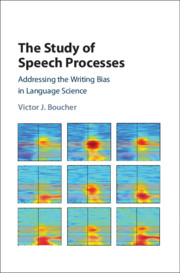Book contents
- The Study of Speech Processes
- The Study of Speech Processes
- Copyright page
- Contents
- Figures
- Tables
- Abbreviations
- Preface
- Introducing a Fundamental Problem of Language Science
- Part I Questions of Ontology: Writing and the Speech–Language Divide
- Part II Questions of Epistemology: The Role of Instrumental Observations
- Part III The Structure of Speech Acts
- Part IV The Processing of Speech Meaning
- 10 The Neural Coding of Semantics
- 11 Processes of Utterance Interpretation: For a Neuropragmatics
- Epilogue
- References
- Index
10 - The Neural Coding of Semantics
from Part IV - The Processing of Speech Meaning
Published online by Cambridge University Press: 14 January 2021
- The Study of Speech Processes
- The Study of Speech Processes
- Copyright page
- Contents
- Figures
- Tables
- Abbreviations
- Preface
- Introducing a Fundamental Problem of Language Science
- Part I Questions of Ontology: Writing and the Speech–Language Divide
- Part II Questions of Epistemology: The Role of Instrumental Observations
- Part III The Structure of Speech Acts
- Part IV The Processing of Speech Meaning
- 10 The Neural Coding of Semantics
- 11 Processes of Utterance Interpretation: For a Neuropragmatics
- Epilogue
- References
- Index
Summary
Research on semantics has largely focused on lexemes in experiments that control for context effects. Several limitations of this approach are discussed along with the ongoing debate between embodied and disembodied viewpoints on the nature of semantic representations. While studies of vocabulary development support a grounding of early semantics in sensory experiences that accompany speech, a lexico-semantic approach fails to acknowledge that meaning is not formatted in utterances in terms of words as in text and dictionaries. In examining polysynthetic languages, a reference to the sensory chunking of speech appears essential in grounding semantic representations in a biological process of utterance segmentation. Moreover, whereas an embodied approach focuses on activations of dictionary-like meanings, a demonstration is provided showing that listeners activate episodes of speech acts.On the issue of the nature of semantic representations, debates in research on lexico-semantics overlook that neural entrainment and cross-frequency coupling constitute a grounding mechanism that can bind multimodal experiences to structures of motor speech.
Keywords
Information
- Type
- Chapter
- Information
- The Study of Speech ProcessesAddressing the Writing Bias in Language Science, pp. 199 - 219Publisher: Cambridge University PressPrint publication year: 2021
